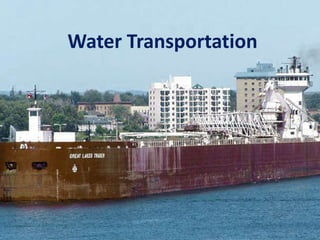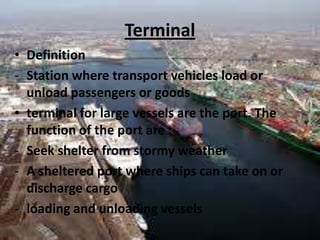Water transportation
- 2. Advantages of Water Transportation ï ïķ Cheap. ïķ Minimum chances of traffic accidents and traffic hazard. ïķ Requires cheap motor powers than for airplanes. ïķ Possesses high load carrying capacity.
- 3. Disadvantages of Water Transportation ï ïķ ïķ ïķ ïķ Limited functionality capabilities. Slow in speed. Difficult to monitor exact location of goods. High weather susceptible.
- 4. WAY Definition:Navigable rivers (once a main highway of communication) There are two types of water ways :-Inland waterways -Ocean waterways
- 5. Inland Waterways -Refer to using inland water bodies like rivers, canals, backwaters, creeks and etc. Ocean Waterways -Navigation along the coastal places and foreign countries take places with the help of ships.
- 6. Terminal âĒ Definition - Station where transport vehicles load or unload passengers or goods âĒ terminal for large vessels are the port. The function of the port are : - Seek shelter from stormy weather - A sheltered port where ships can take on or discharge cargo - loading and unloading vessels
- 7. âĒ - Factors in choosing terminal site : Customer requirement Operational requirement Community requirement Economic requirement
- 8. Unit of Carriage Definition:-The response to the requirement of a particular class of traffic moving on a particular way. -Every mode of transport have a unit of carriage in which the goods or passengers actually move.
- 9. Types of Unit of Carriage For Water Transportation âĒ Ship large, costly unit of carriage âĒ Carry wide variety of product âĒ Represent the part ship building industry
- 10. MOTIVE POWER DEFINITION ï MOTIVE POWER IS AN AGENCY, SUCH AS WATER OR STEAM, USED TO IMPART MOTION ï USED TO IMPORT MOTION TO MACHINERY, A MOTOR, A MOVER










